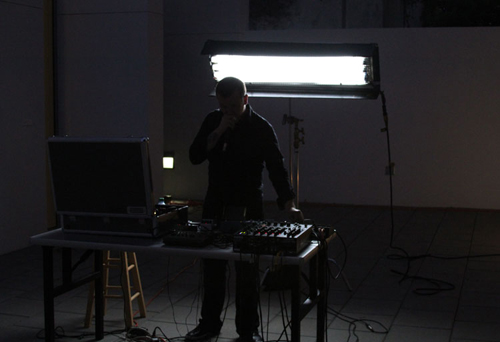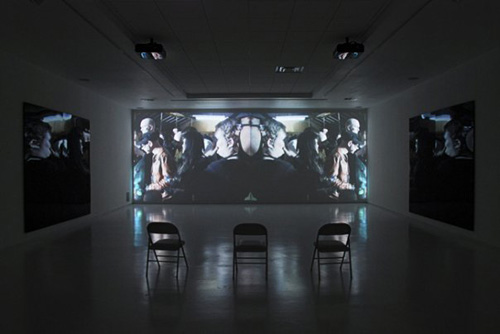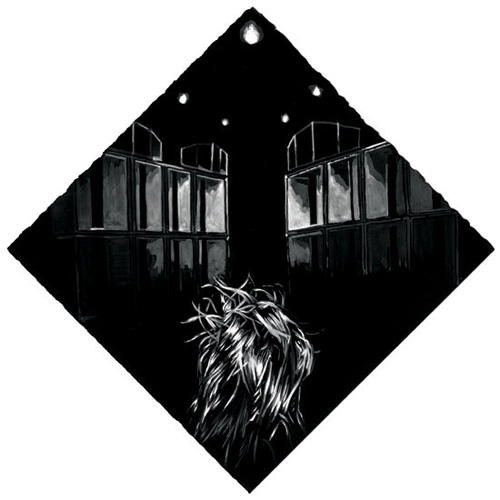
Terence Hannum in Terence Hannum and Nicolas Lobo's "Broadcast Against Recording" performance event at de la Cruz Collection, Miami, Fl, United States, July 9, 2011.
Terence Hannum is a musician and studio artist who has recently relocated from Chicago to Baltimore to teach at Stevenson University. I first met Terence shortly after moving to Chicago myself about two years ago, at an artist book fair held at University Illinois Chicago’s Gallery 400. This event directly followed a concert that Terence performed at the Empty Bottle with Steven Hess and Andrè Foisy as the experimental Drone Metal band Locrian. I was instantly fascinated by Hannum’s art practice, which eloquently moves from stage to studio. And, I have shamelessly been a fan of Terence’s work ever since, attending nearly all of his local performances and writing reviews of his exhibitions. Attending Locrian concerts has been a significant part of my life in Chicago and, in fact, my MA thesis on Black Metal and contemporary art was conceived while I was in the audience at a Locrian concert. Indeed, Terence was the first artist that I asked to be part of my Black Thorns in the White Cube curatorial project.
Terence has shown in solo exhibitions at Depaw University, Indiana; PeregrineProgram and the Museum of Contemporary Art in Chicago; Invisible NYC in New York City; and Light & Sie in Dallas. He has also participated in group exhibitions at Western Exhibitions in Chicago; Photographer’s Gallery in London, UK; Apex Art in New York; and San Francisco Cinematheque, San Francisco, CA; Schalter in Berlin, Germany; and Bergen in Norway. He performs music solo and with the band Locrian, and his zines and publications are in the collections of the Museum of Contemporary Art in Chicago, the School of the Art Institute of Chicago, Indiana University, Herron School of Art and Design, Columbia College Chicago, and DePaul University.
The following interview was sparked by Hannum’s recent exhibition at the Cultural Art Center of Chicago, where he currently has a solo exhibition through the end of December. In addition to the paintings, collages and video on view, he also did a solo performance event the opening week. Taking our conversation beyond this exhibition, I wanted to learn more about his background and how this exhibition compares to his previous exhibitions in Chicago throughout the past year and a half.
Amelia Ishmael: Let’s start with the most obvious question. Why Metal and underground subcultures? What does it mean to you to represent your experiences with these subcultures so dominantly in your paintings, videos, and zines?
Terence Hannum: I have never been interested in much of popular culture. It is entertaining, but after a while it loses its relevance. Subcultures, in general, generate an interesting dynamic, I think, by skirting mainstream attention, for the most part. They tend to generate ways of dress, speaking, codes, sounds, days of remembrance, and hierarchies on their own that force the uninitiated to decipher them. Most of my work began by dissecting different arenas of hardcore and punk music, and then moved into the realm of other, more extreme, underground subcultures. I felt as if this abject periphery was important to address, it raises some interesting questions I can’t quite answer, like, for being so self-proclaimed “profane” in content or aural material, these subcultures can function with very intense definitions as to what is “sacred” for them.
AI: In an interview for fNews last year you mentioned that before studying visual and sonic art you were on a seminary track. It seems like a lot more direct references to historically organized religion and rituals were present in your work just a year or two ago. These ideas are still present in your images, and in your vocal performances, but are gleaned through the metal subculture rather than Catholic imagery. Is this a change in direction?
TH: I did study religion, and still do. To me, it is this vast creative enterprise that encompasses so many of the arts that it is too hard to ignore. Growing up, most of my earliest experiences with music or theater was from being raised Methodist. Although I often don’t know which feeds which, I tend to witness how many instances in the live experience mirror that of the liturgy, or the call and response from preacher to congregation; the meditative qualities of listening to music alone; the minor rituals of unwrapping a LP, placing it on the player, flipping the sides—all of this comes to the fore for me with music, which is perhaps THE central element in most, if not all, rituals across civilizations and eras. Well, that, and music’s prohibition.
AI: Can you tell me about your spirituality and how Metal and headbanging interact with it?
TH: This is a tough question. I am not very religious, but I love experiencing the ritual. I seriously enjoy it, even if I have no attachment to the beliefs involved. When I was young, Metal was presented to me and its content and ferocity was intoxicating. It felt like, at that time, the depths of its speed or intensity knew no bounds and you could always find that band that was more blasphemous and more extreme. This abject content was revered and it opened a gateway for me. I thank Tipper Gore actually, her book Raising PG Kids in an X-Rated Society was like the checklist, even as she was trying to effectively put that music out of reach, it only made it more attractive.
Headbanging is something I have been obsessed with lately, it is quite beautiful to watch, and violent. People can hurt themselves, but it can also be this great genuflection between performer and audience. It’s a motion assigned to a rite and I think it is about denial and erasure, a lack of identity and a desire to be erased into the music. Total annihilation. Sublimity of some kind. So it has a lot of references in fine art with the profil perdu, the lost portrait. I mean, [François] Boucher and [Jean-Antoine] Watteau are Masters, there is so much mystery in those drawings, and through to Edward Weston.
AI: “Amidst Our Throng,” your solo exhibition at the Chicago Cultural Center, includes a range of work from 2008 to 2011. I have a previous relationship with some of these images that are reproduced in the zines of yours that I own, but, of course, the physicality of these paintings is a much different experience. One of the qualities that grabbed my attention in this exhibition is the transition of your brushstroke, which seems to grow gradually more fluid and longer. In “Mass,” from 2008, and “Descent,” from 2010, your paintbrush appears to build a quick, rapid rhythm or texture on the canvas, yet in works such as “Coronation” and “Assumption,” both from 2011, your strokes are more fluid, and there also seems to be a greater play with abstraction and the texture of the paint itself in the black space on the upper portion of “Coronation” and the white space in the center of “Assumption.” What is your painting process like?
TH: Well, the oil paintings take longer, I tend to manipulate different elements a lot and go back to videos and/or photos of the same performance to find things that interest me, and that I want to pull out and paint in an interesting way. They should feel less like pictures and more like paintings. I feel as if every area should somehow be engaging itself and not so reliant on the whole thing. But that’s how I look at a painting; I can get into small areas over the whole thing, especially in a more representational piece. Like, did you ever see that [Jusepe ] de Ribera at the Art Institute, it’s of St. Peter? That forehead is worth the price of admission I think.
AI: These paintings [at the Chicago Cultural Center] are much different from your gouache works on black paper, which appear more like drawings rather than paintings, and seem to extract the images out of the background rather than build additively. Could you tell me a little bit about your variation of materials and approaches?
TH: I consider the gouache on black paper pieces drawings more than paintings. Even though I paint them. I always feel as if those drawings are about the ground, maybe even more than the subject. So, essentially, they are about the void. In my own practice, I don’t ever feel like a painter or a video artist, in the end, it is always about the idea: the content is key and then the media follows. I tend to try an idea in a handful of ways and start to see which best effectively communicates what I am getting at.
AI: Throughout the past two years I have had the pleasure of catching three of your solo exhibitions in Chicago. In reflection, the subject matter of the location of the Metal concert maintains a prevalence, yet from three different approaches. The exhibition at PeregrineProgram seemed really focused on the individual’s experience, with drawings that frequently featured a single audience member or positioning the viewer as the lone member at a performance; your exhibition at Western Exhibitions seemed to highlighted drawings capturing the trajectories of the concert lighting through this vast and dark space, dealing with the concert stage as this nearly metaphysical space; and the exhibition at the Chicago Cultural Center really highlights the concert as a community experience that, for the first time in my experience with your work, reminds me more of Dan Graham’s video “Rock My Religion” (1982-84) than, say, Casper David Friedrich’s “Wanderer” (1818). What is your interaction within these three different approaches?
TH: “Rock My Religion” is a really important touchstone for me. I don’t think I was referring to it in any way directly, but that content is always in my mind. It aged fairly well I think. I do enjoy looking at something like “Rock My Religion” and thinking of the Rooftop Urban Park Project and seeing this burgeoning idea shift material and focus. In those three very different shows I am very conscious about the perspective I want, about the stage or the crowd. I would say the most dramatic is this show at the Cultural Center; it really is about witnessing the ineffable in a live event, but also the weirdness of the pictorial qualities of painting. I mean, most documentation focuses on the performers and not that much on the audience. I wanted to immerse the viewer in that part of it. Like, at a museum, when someone walks in front of a painting, it can be annoying, but it can also shift your perspective a bit. I guess that’s where the idea came from, having the focus of your gaze interrupted.
AI: How does this relate to your experience at concerts? I’ve noticed that very few of these perspectives are taken from the stage where you are often a performer.
TH: Since I play in a band I get to see the stage and all of it being set up and taken down from a different angle. It can allow you some time to think about exactly what you are witnessing. For me it just increases the amount of ideas and content to work from— watching people plug in things, tune drums, set up lights, etc. It’s weird, completely anti-theatrical, it kind of exposes the front, which allows some insight. .
AI: From the analog tape installation “Summoning,” (2010) to the framing/masking of the video “Halo” (2011) [on view at the Cultural Center], to the format of your recent “Pentagon” (2011) drawing series, it seems that you are particularly drawn to the pentagon shape. Why?
TH: Well, it is kind of dumb, but it is basically a pentagram. It is the positive of the five sides. It fills it in. The pentagon has a history in the occult, from the myths around Pythagoras toward astral worship. Supposedly knowing how to generate a pentagon was a sign that you were a member of the Pythagorean cult. So, to me, it is this obvious symbol, and it can be more enigmatic than direct. I use it a lot to establish basis for compositions in images as well.
AI: Can you tell me a little about your background making zines, and how you incorporate them in your creative practice now?
TH: I’ve been making zines since I was about 12. Back then it was more xerox-based and really full of angst. Throughout my life I have always returned to making zines. It wasn’t until 2002 to 2003 that I started making zines as a part of my art practice. It just felt right, like a way to get my sets of drawings out into the public in a non-gallery-centered way. But recently, in 2010, I challenged myself to try and make a publication a month. That culminated in the exhibition at Western Exhibitions. That show, “Negative Litanies,” showcased all twelve publications, which were all very different—some had collaborators and others were different formats or came with audio elements. There wasn’t much time to over-think a release and I would find myself inspired by the material, or a single idea, or going back to xeroxing and copy machines rather than the computer. It initially began when a solo show had to be canceled, and out of that frustration, and bit of mourning, I just decided to use the publication as a vehicle for a curated idea, or collaboration with someone whose work I respected. This year I decided to try and do it every other month, to give myself some sort of break, and I just finished the last book, The Unholy Bow, which is all about headbanging. For 2012 I expect something quarterly to occur.

Terence Hannum, installation view of "The Badge of Punishment (Featuring Prurient)" at Light & Sie, 2008. Two-channel video installation with two acrylic panels.
AI: Whether within your zines or on the stage, your collaborative work also seems a very important part of your practice. You’ve worked previously with Thomas Martin Ekelund, Alexander Binder, Sunn O))), Elijah Burgher, Scott Treleaven, and Nicolas Lobo. How does working with new people impact and change your work? When did you realize that you wanted to do more collaborative work?
TH: You know, it wasn’t initially something I did, collaborate, but it is something I get to do now. It really started with Sunn O))), that was such a positive experience. [Stephen O’Malley and Greg Anderson] were very supportive of the 3-channel video I made [exhibited at 12×12 at MCA Chicago in 2007], but I never actually collaborated very much with them, I just asked them if I could videotape this performance in Chicago to make a video piece and they agreed. Lucky for me [the video] wasn’t horrible. To me they had this great all-encompassing quality live. It definitely gave me more confidence to approach people like Dom from Prurient, or Spencer from Burning Star Core, to make what became a trilogy of investigations [exhibited at Light & Sie in Dallas in 2008]. From there it just developed. Every situation is different, but in the zines it is very much a negotiation between ideas and images and content. With Scott Treleaven, we go back and forth and trade images all of the time, source material and our own work, but it’s been years of us talking, and sharing ideas and images. Collaboration introduces me to so many other ideas and approaches. I think it’s great at least to get you thinking differently about something and having that extra voice to go back and forth with. The last collaboration I did was with Nicholas Lobo, and he is just coming at his work in such an interesting way, using these devices from screw-music or Go-Go, I really can geek out on that. They’re subcultures too, and that I appreciate. I love how he uses these pirate radio stations and publications to disseminate his ideas in a very clandestine way.
AI: In conjunction with your exhibition at the Cultural Center, on October 13th you also gave a solo performance. Will there be more solo sound performances in the future?
TH: Of course. I am hoping in 2012 to incorporate more solo music with the publications. But yeah, I have many more ideas about this. It isn’t done at all.
AI: Thank you Terence!







Pingback: Transmission | An Interview with Niels Geybels: Sequences, Monoliths, and Beneath the Earth | Art21 Blog
Pingback: An Interview with Niels Geybels: Sequences, Monoliths, and Beneath the Earth | wavelengths